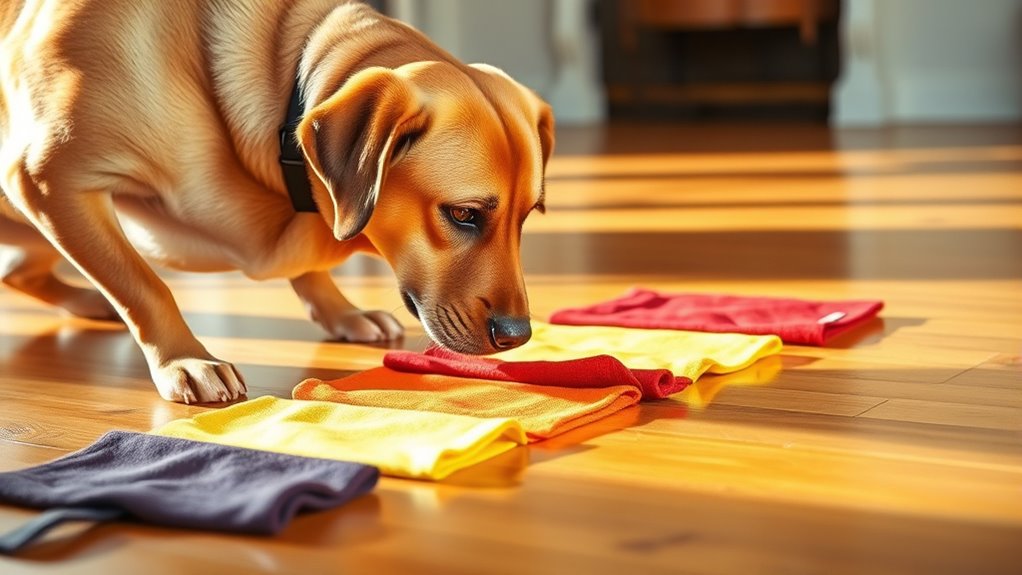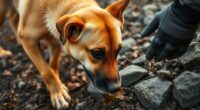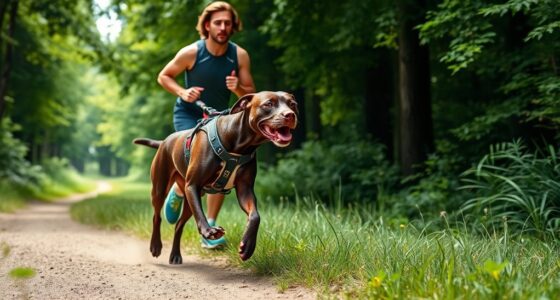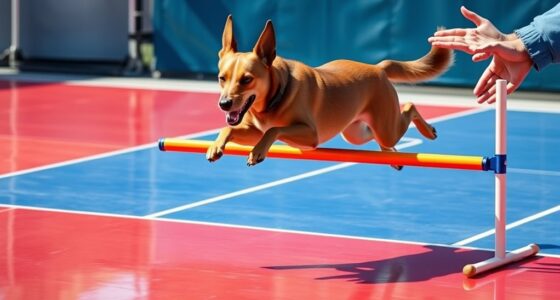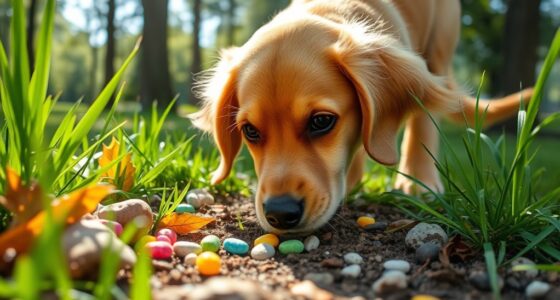To turn your dog into a super sniffer, start by understanding their incredible sense of smell and use simple scent discrimination exercises. Choose safe, strong scents and create a distraction-free environment to boost focus. Gradually increase complexity, rewarding your dog for correct finds. Manage distractions and build confidence step-by-step. With consistent practice and patience, you’ll see your dog excel in scent detection. Keep going, and you’ll discover even more ways to sharpen their extraordinary skills.
Key Takeaways
- Start with familiar, easily recognizable scents and gradually introduce more complex odor scenarios.
- Use positive reinforcement like treats and praise to encourage accurate scent identification.
- Create a distraction-free environment initially, then progressively add mild distractions to build focus.
- Incorporate consistent cues and commands for searching and alerting to reinforce understanding.
- Practice in diverse settings and increase difficulty gradually to develop your dog’s real-world scent detection skills.
Understanding Your Dog’s Natural Olfactory Abilities
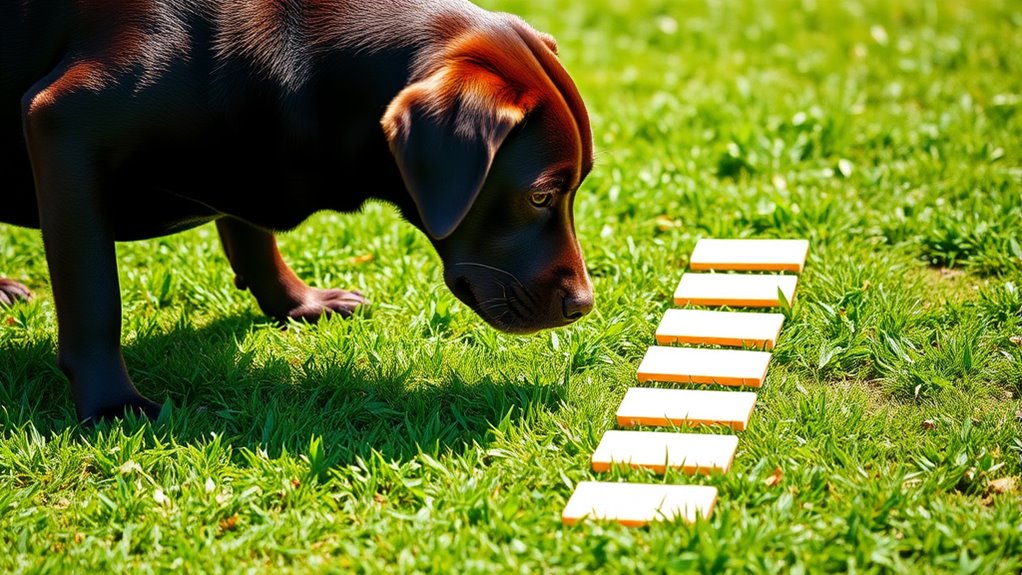
Because dogs have an extraordinary sense of smell, understanding their natural olfactory abilities is essential for effective scent detection training. Dogs have approximately 300 million olfactory receptors, far more than humans, allowing them to detect even the faintest scents. These receptors enable them to build strong scent memories, helping them associate specific smells with objects or locations. When you train your dog, you’re tapping into this incredible olfactory system, encouraging their natural instincts. Recognizing how their scent memory works helps you design better exercises and understand their responses. By appreciating the power of their olfactory receptors, you can motivate your dog to focus, improve their scent discrimination, and develop skills that turn them into exceptional sniffers.
Essential Equipment and Setup for Scent Training
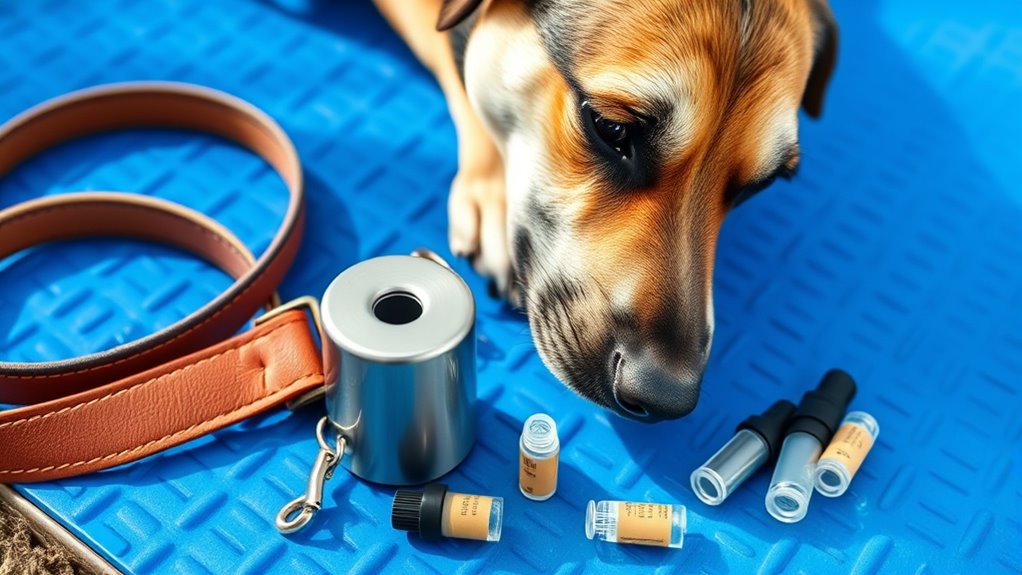
Getting started with scent training requires assembling the right equipment to create a safe and effective environment for your dog. Safety gear is essential; use gloves and protective eyewear when handling scents to prevent contamination and exposure. Clear, secure containers are crucial for scent storage, helping keep the target smells fresh and uncontaminated. You’ll also need a sturdy leash, clicker, and training mats or targets to guide your dog’s focus. Make sure your training area is free of distractions and hazards. A dedicated space helps your dog associate the environment with scent work. Proper equipment not only keeps training safe but also enhances your dog’s ability to concentrate, making the process more successful and enjoyable for both of you. Additionally, understanding the contrast ratio of your training environment can help optimize visibility and focus during scent detection exercises. Incorporating appropriate lighting conditions can further improve your dog’s ability to detect scents accurately. Recognizing the training environment factors can make a significant difference in your scent detection success.
Choosing the Right Scent and Training Environment
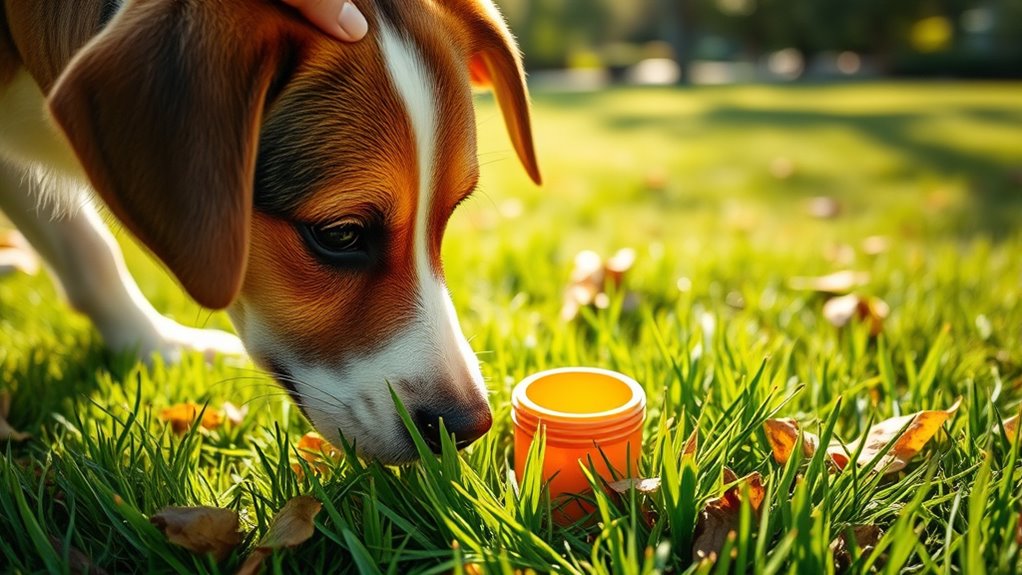
Choosing the right scent and environment is essential for effective training. You want to select safe, non-toxic scents and find a quiet, distraction-free space. Managing background noise and other stimuli will help your dog focus and succeed. Using appropriate scents in a controlled setting can enhance your training results and ensure safety for your dog. Additionally, incorporating training environment considerations can help create an optimal space for your dog’s learning and confidence building. Being aware of air quality and choosing a space with good ventilation can also support your dog’s health and training effectiveness, especially as high-quality air purification can remove allergens and pollutants that might distract or harm your dog. Understanding the influence of technology on training methods can further improve your approach and adapt to modern training tools.
Selecting Safe Scents
Selecting safe scents is essential to guarantee your training environment remains secure and effective. You must prioritize scent safety by choosing non-toxic, natural options that won’t harm your dog. Avoid strong or unfamiliar scents that could cause adverse reactions. Always follow safety precautions to prevent accidental ingestion or inhalation. Consider using essential oils specifically labeled as safe for dogs or commercially prepared training scents. Keep your training area clean and free of any potentially harmful substances. To help you decide, here’s a quick guide:
| Scent Type | Safety Precautions | Suitable Uses |
|---|---|---|
| Natural extracts | Ensure non-toxic, dilute properly | Basic scent training |
| Commercial scents | Follow manufacturer instructions | Advanced detection work |
| Essential oils | Use dog-safe oils, avoid ingestion | Specialized training |
| Household items | Avoid chemicals, chemicals-safe options | Reinforcement training |
| Unscented options | Always verify scent safety | Initial training stages |
Additionally, understanding scent safety and proper training techniques can significantly enhance your dog’s performance and well-being. Incorporating exfoliation benefits from products like glycolic acid can improve your dog’s skin health during training, especially if they are exposed to harsh environments. Being aware of training environment considerations can help prevent accidental exposure to harmful substances and create a safer space for your dog to learn. Recognizing safety protocols in scent detection training ensures both your and your dog’s safety throughout the process.
Ideal Training Settings
Creating the ideal training setting involves carefully selecting both the right scent and a suitable environment that promotes focus and safety. For indoor scent training, choose a quiet, clutter-free space where your dog can concentrate without distractions. This controlled environment helps your dog develop core skills before progressing to more challenging settings. Outdoor scent environments offer a different experience, exposing your dog to natural odors and variable conditions, which can enhance their scent discrimination skills. Whether indoors or outdoors, ensure the area is secure, free of hazards, and allows your dog to work comfortably. Automation technology can be employed to monitor and track your dog’s progress during training sessions, providing valuable insights. Start with simple scent exercises in these environments, gradually increasing complexity as your dog gains confidence and focus. Incorporating positive reinforcement during training encourages enthusiasm and improves learning outcomes. The right training setting lays a strong foundation for successful scent detection development. Vibrational energy also plays a role in maintaining your dog’s focus and enthusiasm during training sessions. Additionally, understanding your dog’s behavioral cues can help you tailor the environment to better suit their learning style. Utilizing appropriate training tools can further enhance your dog’s ability to discriminate scents effectively.
Managing Distractions
Managing distractions is key to effective scent detection training, and that starts with picking the right scent and environment. You want to choose a scent that isn’t overly common or confusing, so your dog can focus on specific distraction triggers. Avoid training in areas with high environmental noise, which can divert your dog’s attention away from the target scent. Start in quiet, controlled spaces to build confidence, then gradually introduce mild distractions. Be mindful of distraction triggers like sudden sounds, movement, or unfamiliar objects that could throw off your dog’s focus. Additionally, understanding the role of fire safety regulations can help you analyze your training progress and optimize your methods through data-driven insights. By carefully selecting your training environment and scent, you help your dog learn to ignore environmental noise and other distractions, sharpening their ability to stay on task in real-world scenarios. Incorporating natural outdoor settings into training can further enhance your dog’s adaptability to diverse environments. Recognizing the importance of training environment control ensures that your dog remains focused and confident during each session. Furthermore, maintaining consistent training routines and using positive reinforcement techniques can significantly improve your dog’s ability to ignore distractions and stay engaged.
Basic Scent Discrimination Exercises
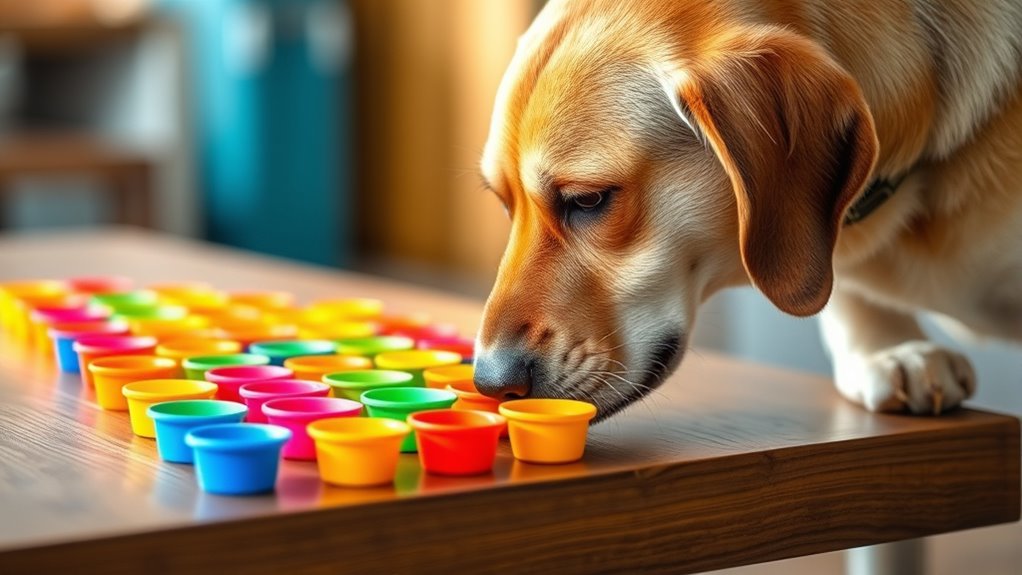
Start by selecting clear discrimination targets that your dog can easily recognize. Introduce multiple scents gradually, encouraging the dog to differentiate between them. When your dog identifies the correct scent, reinforce the behavior with praise or a reward to strengthen their response. Consistent practice enhances their discrimination skills, ensuring more accurate scent detection over time. Incorporating training consistency helps solidify these skills and boosts your dog’s confidence in scent work. Paying attention to nutritional balance can also support your dog’s overall health and performance during training sessions. Ensuring your dog maintains proper hydration is crucial for sustained focus and energy, especially during extended training periods. Proper hydration, including the intake of fiber-rich foods like chia seeds, can aid digestion and maintain your dog’s energy levels during extended training.
Selecting Discrimination Targets
Choosing the right discrimination targets is essential for effective scent detection training. Your goal is to enhance your dog’s odor identification and scent discrimination skills. Start with simple, distinct targets that your dog can easily differentiate. For example, use different materials like cotton, leather, and metal for initial exercises. To help you select targets, consider this table:
| Material | Odor Type | Difficulty Level |
|---|---|---|
| Cotton | Natural fiber | Easy |
| Leather | Organic scent | Moderate |
| Metal | Inorganic scent | Advanced |
This approach guarantees your dog learns to distinguish between various scents and textures, building a solid foundation for more complex discrimination tasks later. Proper target selection maximizes training efficiency and sharpens your dog’s scent discrimination skills.
Introducing Multiple Scents
Building on your dog’s ability to differentiate among various single scents, introducing multiple scents in training exercises helps refine their discrimination skills further. Start by presenting two or three distinct odors with varying concentrations, ensuring each scent remains clear and recognizable. This challenges your dog to focus on scent memory and discern subtle differences despite fluctuations in odor concentration. Use consistent cues and reward correct identifications to reinforce their understanding. As your dog succeeds, gradually increase the complexity by adding more scents or reducing odor intensity. This process sharpens their ability to distinguish between similar smells and improves overall scent discrimination. Remember, patience and consistency are key to helping your dog develop strong, reliable scent recognition skills across multiple odors.
Reinforcing Correct Responses
To effectively teach your dog to distinguish between different scents, reinforcing correct responses is essential. When your dog correctly identifies a target scent, use positive reinforcement like praise, treats, or play to strengthen their scent recognition. This encourages your dog to repeat the behavior and builds confidence in their abilities. Consistently rewarding accurate responses helps your dog understand which scent they’re supposed to find, making the training more effective. Remember, patience is key—don’t punish mistakes; instead, gently redirect and reward the correct response. Over time, this consistent reinforcement solidifies your dog’s ability to discriminate between scents, turning them into a precise and reliable sniffer. Proper reinforcement lays the foundation for advanced scent detection skills.
Building a Strong Search and Find Foundation

Establishing a solid foundation is essential for developing effective scent detection skills. Many people believe in scent detection myths, like assuming dogs will automatically find a scent without proper training. Clarifying these scent training myths helps you focus on building consistent search behaviors. Start by teaching your dog to search in a controlled environment, rewarding early successes. Keep searches simple and increase complexity gradually. Remember, patience is key—rushing can reinforce bad habits. Avoid common scent detection myths that suggest dogs should instinctively understand what to do; instead, reinforce each step. Building a strong search and find foundation ensures your dog develops confidence and accuracy, setting the stage for more advanced scent work later on. Clear, consistent training forms the backbone of a super sniffer.
Incorporating Reward-Based Motivation Strategies
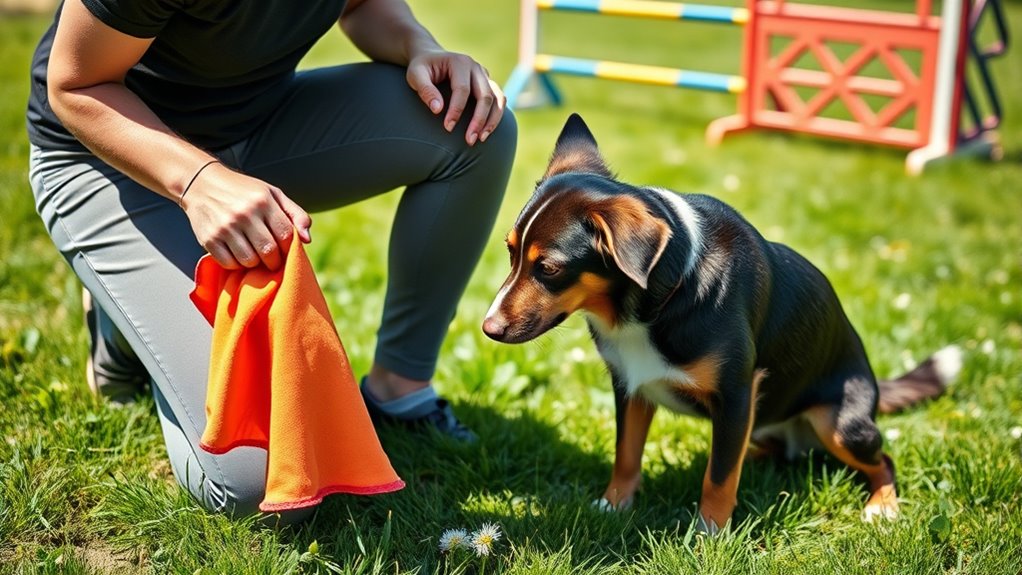
Incorporating reward-based motivation strategies is essential to keep your dog engaged and enthusiastic to learn during scent detection training. Using effective motivational techniques encourages your dog to stay focused and keen to find the target scent. Reward systems, such as treats, praise, or play, reinforce positive behavior and help your dog associate scent detection with enjoyable experiences. Be consistent with your rewards, immediately rewarding your dog when they succeed, to strengthen their understanding. Mix up rewards to maintain interest and prevent boredom. Remember, the goal is to build a positive, fun training environment that motivates your dog to excel. By applying these motivational techniques and reward systems, you’ll foster confidence and enthusiasm, turning training sessions into a rewarding adventure for both of you.
Gradually Increasing Search Complexity
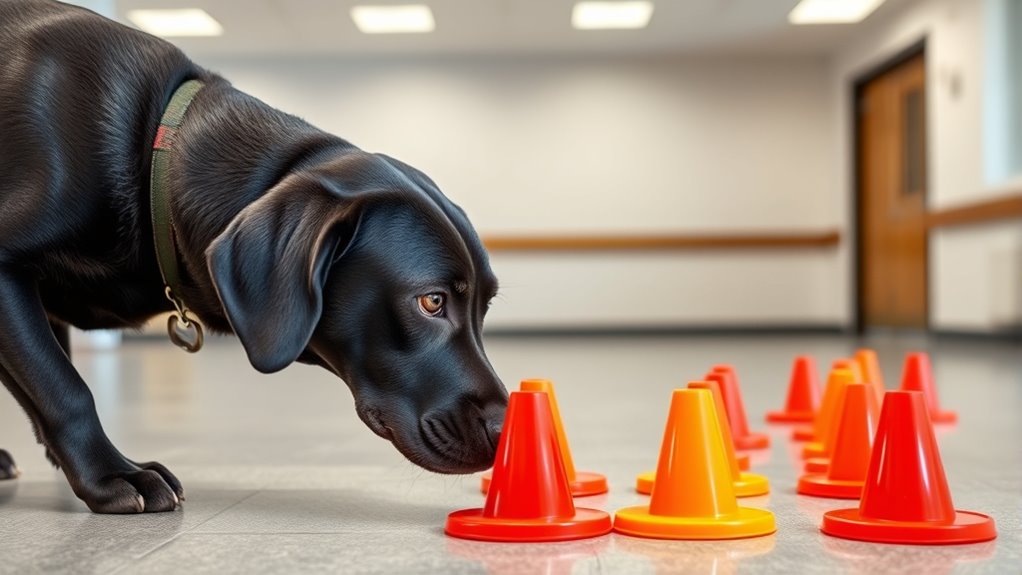
As your dog becomes more confident in scent detection, gradually increasing the search complexity helps build their skills without overwhelming them. Start by reducing odor concentration, making the scent easier to find. Then, introduce scent layering by hiding multiple odors together, challenging your dog to differentiate each one. As they improve, increase the difficulty with more complex searches, such as larger areas or multiple hiding spots. Use the table below to plan your progression:
| Level | Focus | Example | Goal |
|---|---|---|---|
| 1 | Odor concentration | Small container with strong scent | Find easily |
| 2 | Scent layering | Multiple scents hidden in one area | Differentiate odors |
| 3 | Search area size | Larger space with more hiding spots | Cover more ground |
| 4 | Hiding complexity | Hidden in various surfaces or heights | Improve problem-solving |
| 5 | Distractions | Add distractions during searches | Maintain focus |
Troubleshooting Common Challenges in Scent Training
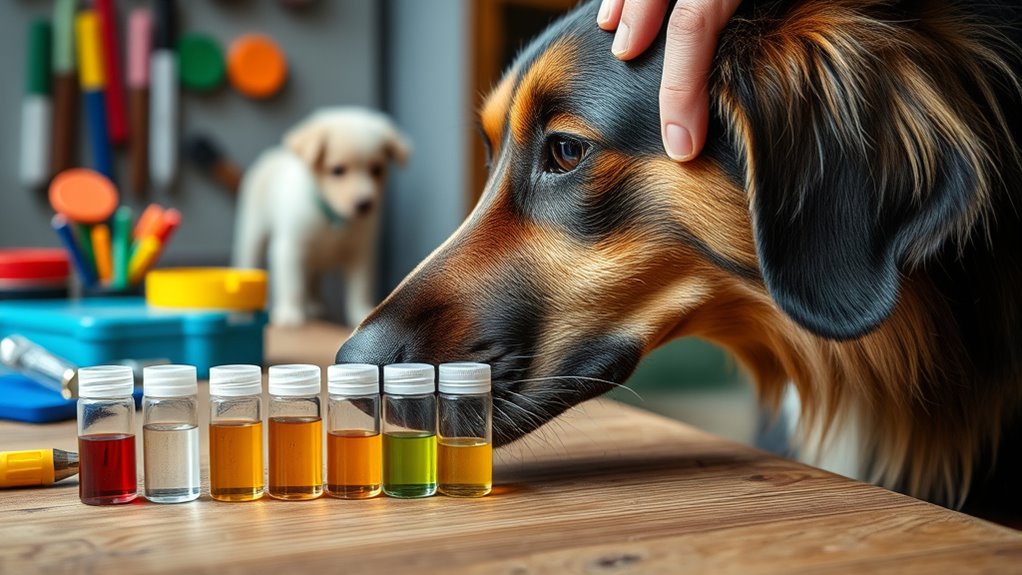
When your dog faces distractions or loses interest, it’s important to address these issues promptly. Building consistent cues helps your dog understand what’s expected, even in noisy environments. By handling distractions effectively and reinforcing cues, you can keep your training on track and ensure steady progress.
Handling Distractions Effectively
Handling distractions effectively is essential for successful scent detection training, especially when your dog encounters unexpected stimuli. Distraction types can range from moving objects and other animals to loud noises or unfamiliar scents. To maintain focus, you need to recognize these triggers early and guide your dog back to the task. Use calm, consistent cues to redirect attention, and avoid scolding, which can increase anxiety. Gradually introduce distractions in controlled environments, increasing complexity as your dog learns to ignore them. Keep training sessions short and positive, reinforcing focus maintenance. Remember, patience is key—your dog will improve with practice and consistency, and mastering distraction management will make your scent detection skills much more reliable in real-world situations.
Building Consistent Cues
Building consistent cues is essential for ensuring your dog reliably responds during scent training, but it can be challenging when cues vary or are unclear. To improve training consistency, use the same cue word or signal every time you want your dog to search or alert. Avoid changing cues or using multiple commands, which can confuse your dog and hinder learning. Focus on cue clarity by pairing your signal with clear, deliberate actions and consistent timing. Practice in short, focused sessions where your cues are always delivered in the same manner. Reinforce the cue with positive reinforcement and praise, so your dog associates the signal with the desired response. Remember, consistent cues build a solid foundation for your dog’s successful scent detection training.
Addressing Loss of Interest
A loss of interest during scent training can stall progress and frustrate both you and your dog. This motivational decline often results from training boredom or repetitive routines that lose excitement. To combat this, keep sessions short and varied, introducing new scents or hiding spots to reignite your dog’s curiosity. Incorporate play breaks and positive reinforcement to reinforce enthusiasm. Changing locations can also stimulate your dog’s senses and prevent boredom. If your dog seems uninterested, slow down and revisit easier exercises to rebuild confidence. Remember, patience is key; pushing too hard can deepen the motivational decline. By maintaining a fun, engaging environment and adjusting your approach, you’ll help your dog stay motivated and enthusiastic to continue their scent detection journey.
Advancing to Real-World Search Scenarios
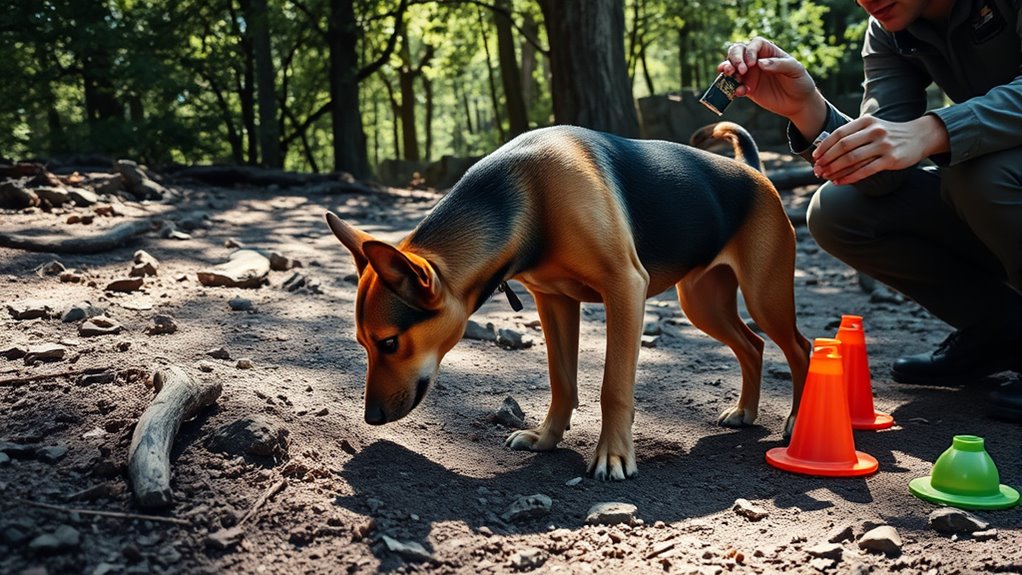
Moving from controlled training environments to real-world search scenarios is a critical step in developing a reliable scent detection team. In these situations, your dog must interpret complex odor analysis, where multiple scent sources and environmental factors influence the scent trail. Pay attention to the scent trajectory, as it guides your dog toward the target amid distractions like wind, crowds, or clutter. Start by gradually increasing the complexity of searches, such as outdoor areas or cluttered indoor spaces. Use consistent cues and reinforce your dog’s confidence in tracking scent movement. Observe how environmental variables affect scent dispersal and adjust your training accordingly. This progression helps your dog learn to adapt to real-world conditions, making their scent detection skills more accurate and dependable.
Tips for Maintaining and Enhancing Your Dog’s Scenting Skills
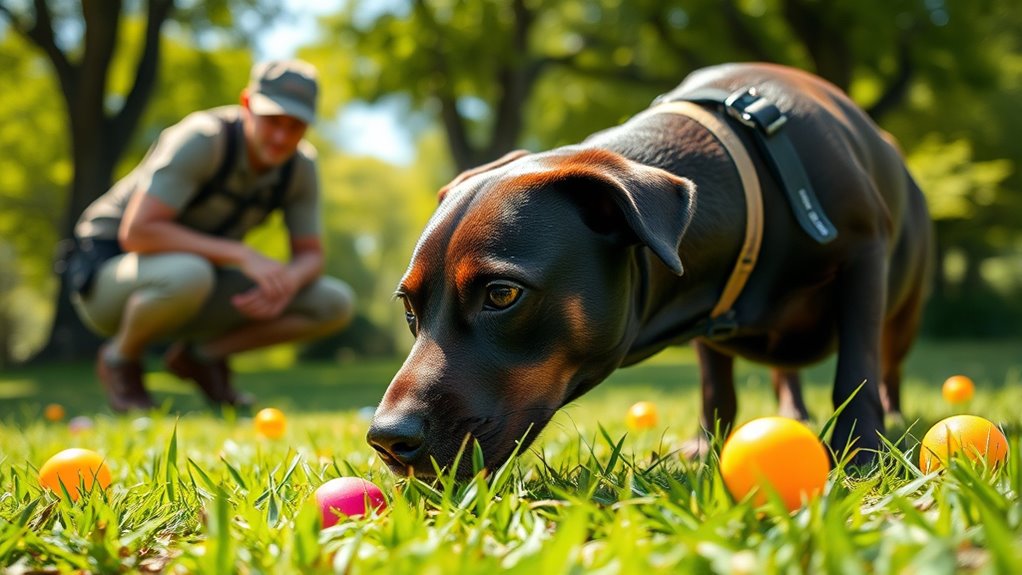
To keep your dog’s scenting skills sharp, regular practice and ongoing reinforcement are essential. Focus on scent preservation by gradually increasing the complexity of search areas and distances, helping your dog retain and refine their skills. Use scent memory techniques, like consistent exposure to specific scents, to strengthen their ability to recall and locate targets over time. Reinforce positive experiences with rewards and praise to boost confidence and motivation. Incorporate varied environments to prevent familiarity from limiting their effectiveness. Regularly revisit foundational exercises to maintain their scent memory and prevent skill deterioration. Consistent training, combined with these techniques, ensures your dog’s scenting abilities stay sharp and ready for any real-world scenario.
Frequently Asked Questions
How Long Does It Typically Take to Train a Dog for Scent Detection?
Training duration for scent detection varies based on your dog’s age, breed, and the complexity of the task. Typically, it takes a few weeks to a couple of months to see steady progress, but the scent learning curve can be steep initially. You should expect consistent, focused training sessions, and patience is key. With dedication, your dog can become proficient in scent detection within a few months.
Can Any Breed Be Trained for Scent Detection, or Are Some Better Suited?
Thinking any breed can become a super sniffer? Well, surprise! Not all are equally suited. Breed suitability and scent training adaptability vary wildly—some dogs like Bloodhounds excel, while others, not so much. So, if you want a nose that works, choose a breed that’s naturally inclined. Don’t just pick any pup; pick one with the genetic gift for sniffing. Your future detective deserves the best!
What Are Signs of Fatigue or Overstimulation During Scent Training Sessions?
During scent training, you should watch for signs of dog fatigue and overstimulation signs. Your dog may yawn, shake, or slow down, indicating tiredness. Overstimulation signs include excessive barking, jumping, or frantic behavior. If you notice these cues, it’s best to take a break to prevent stress or exhaustion. Recognizing these signs helps keep training positive and effective, ensuring your dog stays motivated and engaged.
How Do I Introduce New Scents Without Confusing My Dog?
When introducing new scents, start by practicing scent discrimination with familiar odors first. Then, slowly introduce the new scent alongside the known one, using positive reinforcement. Keep training sessions short to prevent confusion and promote scent generalization. Consistently use the same cues, and gradually increase complexity. This approach helps your dog differentiate scents clearly without getting overwhelmed, building confidence and sharpens their nose skills effectively.
Are There Safety Concerns When Training Dogs With Certain Scents?
Thinking about scent training? It’s important to be aware of potential pitfalls like chemical hazards and allergic reactions. While most scents are safe, some might contain substances that could irritate your dog’s skin or respiratory system. Always choose dog-friendly, non-toxic scents, and monitor your pup closely for any signs of discomfort. If in doubt, consult your vet to ensure your scent training sessions are both fun and safe for your furry friend.
Conclusion
As you reveal your dog’s incredible nose, you might find surprises along the way—like discovering hidden talents you never knew they had. With patience and consistent training, you’ll turn your furry friend into a super sniffer, ready for anything from backyard hunts to real-world rescues. Who knew that a simple scent training session could open up a world of adventure and bonding? Just keep going—you never know what your dog might uncover next.

